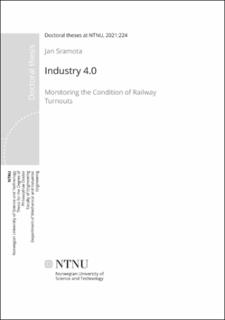| dc.contributor.advisor | Skavhaug, Amund | |
| dc.contributor.advisor | Petersen, Stig | |
| dc.contributor.advisor | Lundteigen, Mary Ann | |
| dc.contributor.author | Sramota, Jan | |
| dc.date.accessioned | 2021-06-15T12:05:06Z | |
| dc.date.available | 2021-06-15T12:05:06Z | |
| dc.date.issued | 2021 | |
| dc.identifier.isbn | 978-82-326-6488-7 | |
| dc.identifier.issn | 2703-8084 | |
| dc.identifier.uri | https://hdl.handle.net/11250/2759558 | |
| dc.description.abstract | Ensuring safety is by far the most important reason for maintaining railway systems. Faults and defects detected early on can in addition be remedied before they cause a service stoppage which is a partial reason why the railway industry is starting to use new digital systems for monitoring important track assets. While many track components can be inspected effectively by the methods used to date, those for the surveillance of particular elements such as railway turnouts are less effective, and new systems have yet to be developed. Due to the large number of turnouts in the railway infrastructure, which is estimated to average one per kilometre of track, these systems must be economically viable and satisfy all the parameters required, which can be particularly demanding.
This thesis presents a system intended for the remote monitoring of railway turnouts, developed during this doctoral study. The system consists of track-side wireless sensors, a gateway and a server. The wireless sensors are attached to the rails and comprise a digital accelerometer, a battery and a communication module, and sense vibration as trains pass over them. When required, the wireless sensors record the vehicle-track interaction and send it wirelessly to the nearby gateway, which forwards the data collected to the server where they are aggregated, analysed and stored. When a defect on the track is identified, relevant trains receive this information immediately via a direct communication channel or indirectly through other infrastructure as programmable balises. Strong integration with existing communication networks and the surrounding infrastructure result in low overall costs for the deployment, operation and maintenance of this system.
The system's usability and performance were assessed on tracks in Denmark and Germany. This revealed issues that made it unsuitable for efficient use on a large scale. Following revision, deficiencies were removed and the system named RailCheck was deployed on the most occupied section of Norway's railway network. Data from a double crossover turnout were collected and released for non-commercial academic and research use as the RailCheck dataset. These data are now available and can be studied for a better understanding of transient events between vehicle-track interactions present in non-ideal datasets, and can be used as a basis for simulations, algorithm development and method verification. This may eventually lead to the creation of reliable algorithms that can be directly applied to real-time measurement systems, enabling autonomous analysis of the state of the track as required for a successful transition to predictive maintenance. | en_US |
| dc.language.iso | eng | en_US |
| dc.publisher | NTNU | en_US |
| dc.relation.ispartofseries | Doctoral theses at NTNU;2021:224 | |
| dc.relation.haspart | Paper 1: RailCheck: A WSN-Based System for Condition Monitoring of Railway Infrastructure Jan Sramota;Amund Skavhaug 2018 21st Euromicro Conference on Digital System Design (DSD) https://doi.org/10.1109/DSD.2018.00067
© 2018 IEEE. Personal use of this material is permitted. Permission from IEEE must be obtained for all other uses, in any current or future media, including reprinting/republishing this material for advertising or promotional purposes, creating new collective works, for resale or redistribution to servers or lists, or reuse of any copyrighted component of this work in other works. | en_US |
| dc.relation.haspart | Paper 2: RailCheck: Functional Safety for Wireless Condition Monitoring of Railway Turnouts and Level Crossings Jan Sramota;Mary Ann Lundteigen;Stig Petersen;Amund Skavhaug 2019 IEEE Intelligent Transportation Systems Conference (ITSC) https://doi.org/10.1109/ITSC.2019.8917093
© 2019 IEEE. Personal use of this material is permitted. Permission from IEEE must be obtained for all other uses, in any current or future media, including reprinting/republishing this material for advertising or promotional purposes, creating new collective works, for resale or redistribution to servers or lists, or reuse of any copyrighted component of this work in other works. | en_US |
| dc.relation.haspart | Paper 3: RailCheck Dataset of Vehicle-Track Interaction Measured on Railway Turnouts. Jan Sramota and Amund Skavhaug | en_US |
| dc.title | Industry 4.0 Monitoring the Condition of Railway Turnouts | en_US |
| dc.type | Doctoral thesis | en_US |
| dc.subject.nsi | VDP::Technology: 500::Mechanical engineering: 570 | en_US |

